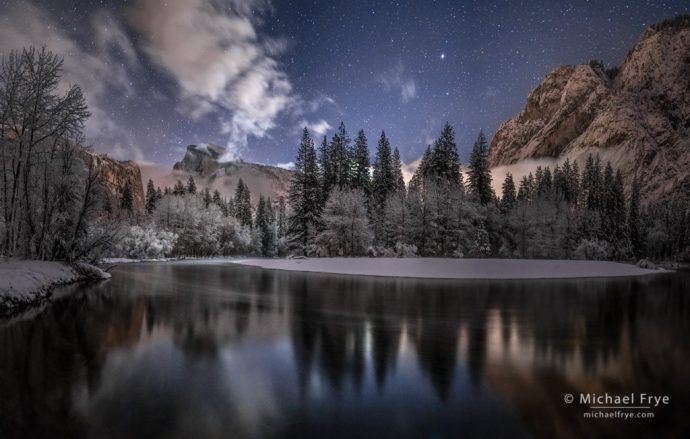Happy New Year everyone! I hope you all have a wonderful year in 2017.
Tomorrow I’ll be posting the nominees for my best photos of 2016, and you’ll get a chance to vote for your favorites and help me pick the top ten. Keep an eye out for the post! You can see last year’s nominees here, and the winners here.
I made this image around 4:20 a.m. last Saturday morning (Christmas Eve) after a few of inches of snow fell in Yosemite Valley. I actually drove up to the valley around 9:30 on Friday evening, since it looked like the storm was about to clear. But clouds and snow flurries persisted for awhile, and skies didn’t start to clear in ernest until after midnight.
The moon wasn’t due to rise until 2:55 a.m., but as I found out last winter, it’s possible to photograph a clearing storm just by starlight, especially with snow to help lighten the foreground.
But the light got even more interesting after the moon came up. The moon was only 20% full, so when it first rose it was hard to see any effect. But as the moon climbed higher its light became stronger. I ended up in the eastern end of the valley photographing Half Dome and the Merced River, with clouds and mist backlit by the rising moon. Lights from Curry Village cast a warm glow onto some of the cliffs, and because the moonlight was so dim I could still see plenty of stars in the sky. It was a beautiful combination of moonlight, starlight, and manmade light.
Once again I stitched several images together to get a very wide-angle view (probably equivalent to about 14mm). I used Lightroom’s Panorama Merge to blend four frames together, then cropped a little bit. The camera was a Sony A7r II (that’s the only camera I use these days) with a Rokinon 20mm f/1.8 lens. The exposures were 20 seconds at f/2.8, 3200 ISO.
Have a wonderful – and safe – New Year’s Eve, and check back here tomorrow to see the best-of-2016 nominees!
— Michael Frye
Related Posts: A Clearing Storm by Starlight; Picking My Best Images of 2015; My Top Photographs of 2015
Michael Frye is a professional photographer specializing in landscapes and nature. He is the author or principal photographer of The Photographer’s Guide to Yosemite, Yosemite Meditations, Yosemite Meditations for Women, Yosemite Meditations for Adventurers, and Digital Landscape Photography: In the Footsteps of Ansel Adams and the Great Masters. He has also written three eBooks: Light & Land: Landscapes in the Digital Darkroom, Exposure for Outdoor Photography, and Landscapes in Lightroom: The Essential Step-by-Step Guide. Michael has written numerous magazine articles on the art and technique of photography, and his images have been published in over thirty countries around the world. Michael has lived either in or near Yosemite National Park since 1983, currently residing just outside the park in Mariposa, California.










Beautiful, Michael! Very unusual. Sometime I’d like to hear more details on how you processed this. Happy New Year to you too!
Thanks Fred!
This Is So Beautiful Michael.
Best Wishes & Wishing You & All Your Family A Happy New Year For – 2017.
Thanks John – Happy New Year to you too!
Why isn’t depth of field a problem at F/2.8? Thanks.
First, because I used a 20mm lens, and wide-angle lenses like that provide lots of depth of field, even at f/2.8. Second, because there wasn’t much depth to the scene. The closest thing to the camera was the trees and riverbank on the left edge, and those were probably at least 50 feet away, which is essentially at infinity for a 20mm lens.
Very helpful! And best wishes for the coming year.
The image is stunning!
Thanks Jesse!
Another beauty! I was wondering whether you had done anything in the LR or PS to reduce the noise. I was also in the valley at the same time but stayed on the west side. I was shooting Pentax 645D at ISO 1600 wide open for two minutes, but the noise is quite visible.
Thanks again for sharing and wish you a Happy New Year!
Best,
George
Thanks George. I used only Lightroom for processing this image, and yes, I always reduce noise with high-ISO images. Lightroom’s best tool for noise reduction is actually the masking slider in the sharpening panel. This is something I talk about in one of the videos that goes with my Lightroom ebook.
I can’t comment on the noise characteristics of the Pentax 645D, since I’ve never used it. But when you say the noise is quite visible, is that when viewing the image at 100%? If so, you’re looking at a highly-magnified view, and you probably won’t see that much noise in a print. This all depends on the resolution of the camera and of the monitor you’re viewing the image on, but on my laptop, for example, when looking at 42 MP images from my Sony A7r II at 100%, I’m seeing the equivalent of a section of a 70-inch wide print (for a horizontal image). Since the largest prints I make are 40 inches on the long side, I find that a 50% magnification is a better way to evaluate noise. Again, this depends on the resolution of your camera and monitor, so you have to find the magnification that works best for you. How much noise you’ll tolerate also depends on how big a print you plan to make, and there’s also, of course, a certain amount of subjectivity regarding how much noise is acceptable.
Dear Michael
Thanks so much for your detailed reply! I have been looking my file at 200%. Even with 50 %,the noise is still quite visible. I think it may be the intrinsic problem of Pentax 645D. And I will try to learn more on Lightroom to reduce the noise.
Best
George